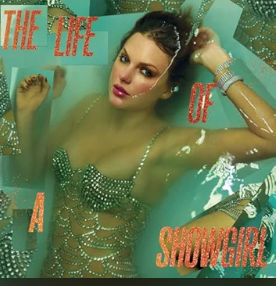
I vividly remember my first “women supporting women” moment. My friends and I were sitting in the back of the school bus in the Spring of 2007, giggling like the seventh graders we were. My best friend was writing a note to her crush—only it was actually the lyrics of “Teardrops on My Guitar” with the name “Drew” changed to the name of a cute boy from a neighboring school. When she couldn’t remember all the words, we each broke out our MP3 players to listen painstakingly to the song over and over and over again to get each lyric correct. Communal moments like this have occurred numerous times over the years as friends, family members, colleagues, and I have bonded over Swift’s music and life. The genuine child-like exuberance I felt when Swift announced her latest album was only matched by the exhilaration I felt in seeing Swift’s engagement announcement.
The Life of a Showgirl is perhaps the most anticipated album of the year (and with high anticipation comes high expectations). Since the album’s release on October 3, the reviews have demonstrated a mixed reception. I generally do not enjoy joining a throng of critics and musical “Monday Morning Quarterbacks,” but I think Swift has created an album worth reflection. I do not have experience writing, producing, or reviewing music. However, my long-time membership as a Swiftie will hopefully give me some credibility where I might otherwise fall short.
This album is a departure from her more recent work, both musically and psychologically. Although I find this album thoroughly fun and energetic (in many ways, it is a return to her pre-Folklore pop eras), I am struck by the dissonance in comparison with her recent albums. Both Midnights and The Tortured Poets Department were longer albums, rife with psychological complexity–full of self-doubt and heartbreak, interspersed with sentimental love songs. Conversely, The Life of a Showgirl is more focused, and Swift saturated this album with her rapturous exultation in romantic new heights (pun intended). Swift seems to be lifting the curtain on her life by giving us an intimate view of her romantic relationship with Travis Kelce (perhaps most revealingly in “Wood”). As she revels in her current happiness, Swift also provides brief glimpses into the past barriers to experiencing relational peace. Some of those barriers were external, but some were internal. Yet, by the end of the album, she closes the curtain, reminding us that she is the quintessential showgirl whose personal life is not for public consumption. Swift’s songwriting chops are still evident on this album, yet her vulnerability is less transparent…and I believe that is exactly the point.
Swift reflects this in her track list organization. In keeping with the showgirl theme, the first three tracks serve as an overture of sorts. “Fate of Ophelia,” “Elizabeth Taylor,” and “Opalite” introduce the primary themes of this album and serve as a likely romantic overture to Kelce. Throughout these three songs, Swift explores themes such as how secure love has rescued her from despair and disillusionment, how love can be a respite from the fickleness of fame, and how she feels grounded in joy and contentment. Each of these themes is woven throughout the remaining nine tracks.
On my first listen, I was struck by the stark contrast between tracks 4, 7, and 10 (“Father Figure,” “Actually Romantic,” and “CANCELLED!” respectively) and tracks 5, 8, and 11 (“Eldest Daughter,” “Wi$h Li$t,” and “Honey”). Take the pairing of “Father Figure” and “Eldest Daughter” as an example (and I do think they are best understood as a pair). “Father Figure” provides a profound psychological exploration of the dynamics between a powerful, mafia-esque industry figure and his protege. Swift draws her audience into this dark tale and then abruptly shifts the mood by following “Father Figure” with a tender love song, “Eldest Daughter”, that details a rejection of the politics and savagery of the “empire” she has courted all these years.
Like any true Swiftie, I know that every track 5 on a Swift album is her most introspective. “Eldest Daughter” is no different in that respect, but it is different from most fifth tracks in that it is not about heartbreak or her history of insecure attachment —it’s about the return of innocence and attachment security. Swift narrates the donning of her self-protective veneer by penning a couple of lines that play on a biblical metaphor (something Swift has done numerous times). She sings, “Every eldest daughter/was the first lamb to the slaughter/so we all dressed up as wolves and we looked fire.” Swift reverses the metaphor found in the Sermon on the Mount that Jesus uses to warn his listeners about wolves (i.e., false prophets) pretending to be sheep to sneak into the fold (Mattew 7: 15). “Father Figure” is told from the perspective of a calculating “wolf” who knows all the schemes to protect his empire; “Eldest Daughter” is about a prodigal sheep who realizes true joy is found in shedding her “wolfskin” and embracing the simple beauty of “Ferris wheels, kisses, and lilacs” alongside the man who loves her.
In the end, the glitz and glamour of Swift in her Showgirl era seem to contradict her romanticization of the quiet life found in earlier albums. The title track, “The Life of a Showgirl,” portrays the entertainer persona as central to Swift’s identity. She is not leaving the empire of the music industry, but she is exploring how to inhabit the space differently–not as a wolf, but as a joyful, contented sheep.
While Swift is certainly not rooting her transformation in a Christian virtue ethic, this call to reject the tactics of the “wolves” is a call that Christians should take seriously. We have become accustomed to looking for wolves in sheep’s clothing. But we, the sheep, must consider how we all too readily adopt the demeanor of wolves in public discourse and private relationships. Where anger and vitriol have become the norm, may we take the way of compassion and gentleness. Maybe we can still take a page from Swift’s playbook and cherish the obscure life where a “driveway with a basketball hoop” tops our “Wi$h Li$t”. Maybe we could cultivate more communal moments like seventh-grade girls co-laboring to ensure a dear friend wins the heart of her crush.


2 Responses
Dr. Stovall, as always, your TS takes are spot on here. Thank you for your reflections. I agree and found myself wishing for something different, but also recognizing the depth hidden beneath the bops.
Thanks for your thoughtful and insightful “hot take” on TS’s new album. I found it illuminating and prompting me to go back and listen more carefully to the conversation the tracks are having with each other. Thanks, Jessica!!